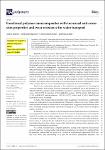Functional Polymer Nanocomposites with Increased Anticorrosion Properties and Wear Resistance for Water Transport
| dc.contributor.author | Buketov, A | |
| dc.contributor.author | Sapronov, O | |
| dc.contributor.author | Klevtsov, K | |
| dc.contributor.author | Kim, B | |
| dc.date.accessioned | 2023-09-01T15:00:21Z | |
| dc.date.available | 2023-09-01T15:00:21Z | |
| dc.date.issued | 2023-08-18 | |
| dc.identifier.issn | 2073-4360 | |
| dc.identifier.issn | 2073-4360 | |
| dc.identifier.other | 3449 | |
| dc.identifier.uri | https://pearl.plymouth.ac.uk/handle/10026.1/21277 | |
| dc.description.abstract |
Corrosive destruction and hydroabrasive wear is a serious problem in the operation of machine parts and water transport mechanisms. It is promising to develop new composite materials with improved properties to increase the reliability of transport vehicles. In this regard, the use of new polymer-based materials, which are characterized by improved anticorrosion properties and wear resistance, is promising. In this work, therefore, for the formation of multifunctional protective coatings, epoxy dian oligomer brand ED-20, polyethylene polyamine (PEPA) hardener, a mixture of nanodispersed compounds with a dispersion of 30–90 nm, fillers Agocel S-2000 and Waltrop with a dispersion of 8–12 μm, and particles of iron slag with a dispersion of 60–63 μm are used for the formation of multifunctional protective coatings. Using the method of mathematically planning the experiment, the content of additives of different physico-chemical natures in the epoxy binder is optimized to obtain fireproof coatings with improved operational characteristics. A mathematical model is developed for optimizing the content of components in the formation of protective anticorrosion and wear-resistant coatings for means of transport as a result of the complex effect of a mixture of nanodispersed compounds, iron scale, and Waltrop. Based on the mathematical planning of the experiment, new regularities of increasing the corrosion resistance and resources of the means of transport are established through the formation of four different protective coatings, which are tested for resistance to aggressive environments (technical water—CAS No. 7732-18-5, gasoline—CAS No. 64742-82-1, acetone—CAS No. 67-64-1, I-20A lubricant—CAS No. 64742-62-7, sodium solutions—CAS No. 1310-73-2, and sulfuric acid—CAS No. 7664-93-9) and hydroabrasive wear resistances. A study of the change in the permeability index in aggressive environments is additionally carried out, taking into account the rational ratio of dispersive fillers in the epoxy binder, which made it possible to create an effective barrier to the penetration of aggressive water molecules into the base. A decrease in the permeability of protective coatings by 2.0–3.3 times relative to the epoxy matrix is achieved. In addition, the wear resistance of the developed materials under the action of hydroabrasion is investigated. The relative resistance of the CM to the action of hydroabrasion was found by the method of materials and coatings testing on the gas-abrasive wear with a centrifugal accelerator. This method enables one to model the real process of the wear of mechanism parts under the hydroabrasive action. It is shown that the coefficient of the wear resistance of the developed materials is 1.3 times higher than that of the polymer matrix, which indicates the resistance of the composites to the influence of hydroabrasive environment. As a result, modified epoxy composite protective coatings with improved anticorrosion properties and wear resistance under hydroabrasive conditions are developed. It is established that the protective coating filled with particles of a mixture of nanodispersed compounds (30–90 nm), iron scale (60–63 μm), and Waltrop (8–12 μm) has the lowest permeability indicators. The permeability in natural conditions of such a coating during the time t = 300 days of the study is χ = 0.5%, which is 3.6 times less than the similar indicators of the epoxy matrix. It is substantiated that the protective coating filled with particles of a mixture of nanodispersed compounds (30–90 nm), iron scale (60–63 μm), and Agocel S-2000 (8–12 μm) is characterized by the highest indicators of wear resistance. The coefficient of wear resistance under the action of hydroabrasion of such a coating is K = 1.75, which is 1.3 times higher than the similar indicators of the original epoxy matrix. | |
| dc.format.extent | 3449-3449 | |
| dc.format.medium | Electronic | |
| dc.language | en | |
| dc.publisher | MDPI | |
| dc.subject | epoxy resin | |
| dc.subject | hardener | |
| dc.subject | nanopowder | |
| dc.subject | filler | |
| dc.subject | corrosion | |
| dc.subject | wear resistance | |
| dc.subject | mechanical characteristics | |
| dc.subject | water transport | |
| dc.title | Functional Polymer Nanocomposites with Increased Anticorrosion Properties and Wear Resistance for Water Transport | |
| dc.type | journal-article | |
| dc.type | Article | |
| plymouth.author-url | https://www.ncbi.nlm.nih.gov/pubmed/37631509 | |
| plymouth.issue | 16 | |
| plymouth.volume | 15 | |
| plymouth.publication-status | Published online | |
| plymouth.journal | Polymers | |
| dc.identifier.doi | 10.3390/polym15163449 | |
| plymouth.organisational-group | |Plymouth | |
| plymouth.organisational-group | |Plymouth|Faculty of Science and Engineering | |
| plymouth.organisational-group | |Plymouth|Faculty of Science and Engineering|School of Engineering, Computing and Mathematics | |
| plymouth.organisational-group | |Plymouth|REF 2021 Researchers by UoA | |
| plymouth.organisational-group | |Plymouth|Users by role | |
| plymouth.organisational-group | |Plymouth|Users by role|Academics | |
| plymouth.organisational-group | |Plymouth|REF 2021 Researchers by UoA|UoA12 Engineering | |
| dc.publisher.place | Switzerland | |
| dcterms.dateAccepted | 2023-08-14 | |
| dc.date.updated | 2023-09-01T15:00:15Z | |
| dc.rights.embargodate | 2023-9-5 | |
| dc.identifier.eissn | 2073-4360 | |
| dc.rights.embargoperiod | forever | |
| rioxxterms.versionofrecord | 10.3390/polym15163449 |


